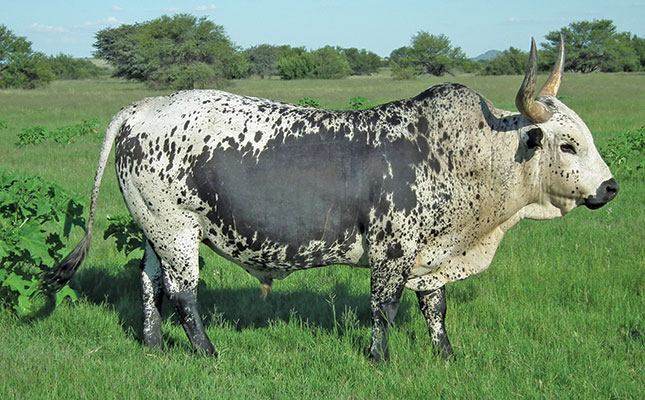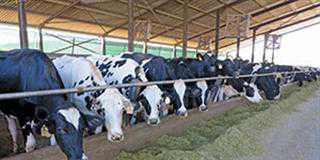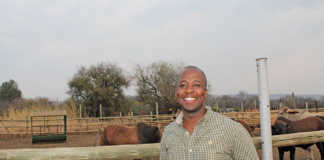
Photo: Michiel van Niekerk
Environmental factors, of which herd management forms an integral part, exert a 70% influence on the performance of an adult bull, whereas genetics account for only 30%.
This means that the nutrition of young bulls is crucial to ensuring a top-performing adult animal, according to Dr Francois van de Vyver, national technical manager at Voermol Feeds. He warns, however, that putting young bulls on high-concentrate rations can be detrimental to their future fertility and soundness.
Feed for muscle growth
As bulls grow, their nutritional requirements change. Mature bulls use nutrients primarily
for maintenance, whereas younger animals require nutrients to support growth,
development and maintenance.
Nutritional requirements must be met in full to develop growing bulls from weaning onwards, but feeding a young bull a high-energy diet after weaning will result in rapid weight gain, which can create a host of problems such as a reduction in semen quality. In addition, an excessively fat bull will be lazy and unhealthy.
Animals go through different phases of growth on the road to adulthood. “It’s therefore vital that animals are fed according to their nutritional demands at the different stages of tissue development,” explains Van de Vyver.
Young bulls need rations that are high in crude protein (CP) to ensure the best possible muscle development.
Muscle, which consists mainly of protein, develops rapidly at a young age, which makes the choice of protein in the diet very important. According to Van de Vyver, the ideal is natural protein sources with very little, if any, non-protein nitrogen (NPN) feed. If the energy value of young bulls’ feed is increased excessively, the animals can develop reproduction problems such as fat deposits in their scrotums, which can cause a decline in their fertility.
Van de Vyver adds that the use of grains in young bulls’ feeding rations should be approached with caution, as a high percentage of grain can lead to obesity. Where grains are used, it is best to combine them with natural high-calibre protein to allow for a moderate growth rate. Lick supplements on good-quality veld are also an option, but this means the young animals will maintain a slow growth rate and will take longer to reach the stage where they are ready for inclusion in a reproductive herd.
A young bull should be fit and athletic, not fat. Van de Vyver therefore recommends a daily ration that is 1,5% to 2% of body weight and contains 12% to 14% CP.
“Breeders would be well advised to make sure the animals have plenty of free-choice forage. The rule of thumb is to feed a 14% CP ration until 14 months of age,” he explains.
Bulls should also not be allowed to become too lean, as they will suffer from the same reproduction problems as overfed animals. At the beginning of the breeding season, the ideal body condition score (BCS) for a bull is 3,5 on a five-point scale.
A bull with a BCS of two will achieve a breeding soundness evaluation (BSE) of 55%, while a BCS of three to 3,5 will achieve a BSE of 72%. At a BCS of four, an overly fed bull will have a BSE of 66%.
Genetic potential and accurate feeding
In Van de Vyver’s opinion, one of the biggest mistakes a breeder can make is to chase high growth rates at all costs. He says that the respective breed society standards should be followed diligently as far as growth rates are concerned.
A bull’s growth should be determined largely by its genetic potential coupled with accurate feeding. If the nutritional needs of a bull from weaner to yearling are not met, its growth rate will be reduced, and this could lead to delayed pubertal development.
Bulls are often backgrounded or intensively fed in preparation for shows and auctions. Buyers of such bulls should give the animals time to adapt to their new environments and space to exercise; this will help to ensure the highest reproduction rates. Bulls should therefore not be purchased too close to the breeding season.
“The fertility of bulls fed specifically for shows and auctions is not permanently affected [by such feeding], as long as they were fed according to their nutritional requirements during growth and development,” says Van de Vyver.
Lick supplements
Turning to a young bull’s mineral and vitamin requirements, Van de Vyver recommends the use of a normal three-phase lick supplement programme that kicks off with a phosphorus and trace-element lick (usually referred to as a phosphate lick) on green veld in summer.
Although animals will pick up weight when the veld is green, a phosphorus deficiency can limit growth.
A winter protein lick is advisable to prevent weight loss during the more taxing winter months, while protein and energy licks are recommended to prevent weight loss in late winter and early spring.
Van de Vyver points out that an animal’s nutritional needs are determined by its physiological needs as well as environmental factors. Large-framed beef cattle breeds’ nutritional demands are obviously higher than those of small-framed breeds because of their maintenance requirements.
Environmental factors such as temperature, humidity and terrain, among others, also affect the nutritional requirements of livestock, including young bulls.
The energy requirements of animals kept in very cold conditions and those that have to walk great distances will differ from the needs of animals from more temperate areas and those that don’t need to walk far.
“My advice to beef cattle producers is firstly to select animals that are adapted to the areas and environments they farm in. Secondly, look after the animals’ growth and development from an early age so that they will eventually become top performers. You can’t change an animal’s genetics, but you can manage the environment it grows up in by feeding it accordingly,” says Van de Vyver.
Communal farmers
Managing young animals can be challenging for communal farmers. Van de Vyver suggests that they work together to manage and conserve the veld and allow parts of the grazed veld to rest for a season or two. If this is not possible, another option is to kraal young bulls overnight with a supply of roughage such as hay, as well as the relevant licks.
Van de Vyver says the use of protein licks in communal farming concerns should be seriously considered because of the poor and limited grazing available to cattle in most communal farming areas. Protein licks, and even those that contain NPN, for that matter, must always be fed in conjunction with ample supplies of roughage.
Production licks are invaluable before breeding season and when animals are in poor condition.
“Because it’s difficult for communal farmers to stick to specific breeding seasons, I strongly recommend that they follow the three-phase lick supplement programme, and allow the quality and availability of the veld to guide them,” he says.
Email Francois van de Vyver at [email protected].












